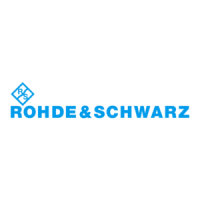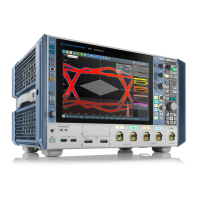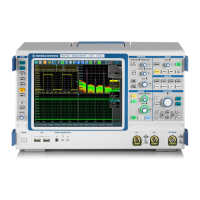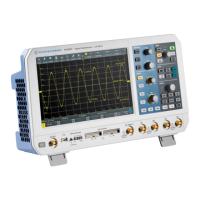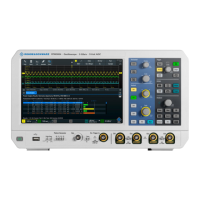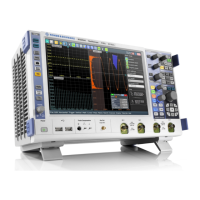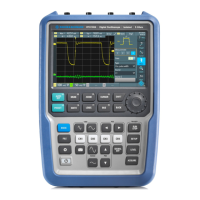Protocol analysis
R&S
®
RTE
767User Manual 1326.1032.02 ─ 20
NRZ code requires only half the bandwidth of Manchester code, and it can either be
clocked or unclocked. NRZ unclocked signals require a user-defined bit rate and gap
time setting for triggering and decoding.
13.14.1.1 Special features of Manchester coding
In practical protocols, Manchester coding appears in many variations, often employing
deliberate coding violations to encode special waveform features, such as unambigu-
ous synchronization and termination patterns. To adapt to these specific Manchester
implementations and handle ambiguous signals, the option R&S RTE-K50 for Custom
Serial Bus uses a combination of automatic algorithms and user configurable parame-
ters.
Quaternary Symbols
The software supports not just traditional binary symbols "0" and "1", but also arbitrary
violation waveforms that use two additional symbols, yielding a total of four valid "qua-
ternary bit" values. The two additional violation symbols are "H" (high) and "L" (low).
Values of "H" correspond to a waveform lacking a transition in the center of the bit, with
a physical high voltage state. Similarly, "L" violations also lack a center transition, but
have a physical low voltage state. Most Manchester synchronization and termination
conventions, even those containing violations, may be expressed as sequences of
these four symbols. R&S RTE-K50 uses the quaternary notation to support Manches-
ter patterns in the honeycomb display and to describe synchronization and termination
patterns in the frame description table.
Idle Conditions
The state of the signal line in between messages is the idle condition. Manchester
appears in practical standards with varying idle conditions: it can idle at the high, low,
or middle voltage state. High and low idle states correspond to "biphase" Manchester,
while the middle voltage (often ground) adds a third state to become "ternary" Man-
chester. Using ternary Manchester, option R&S RTE-K50 can usually establish the
gaps between messages automatically. Using binary Manchester, the software has no
way to automatically discriminate an idling bus from monotonic sequences of "H" or "L"
violations. For these biphase situations, R&S RTE-K50 offers a "Gap Time" detection
feature, which allows to distinguish long intervals of non-transitions between bus idling
and sequences of violations. Other differences between biphase and ternary Manches-
ter are managed automatically by the software, with no user input required.
Edge Conventions
Most Manchester encodings establish the beginning of the first bit by a first transition,
hence an "overhead" edge. The center of the bit is then marked by a second transition,
which is a "sampling" edge. Some Manchester implementations, however, sample the
first bit on the first edge. The option R&S RTE-K50 attempts to automatically detect
this situation. Unfortunately, it is possible to trick the algorithm with waveforms that
contain many (legitimate) violations. In these situations, the user can force a "First
Edge" or "Second Edge" convention for handling edges. Edge sampling according to
the "First Edge" convention is more likely to appear in biphase Manchester, but the
software also supports this setting for ternary Manchester situations.
Custom: Manchester / NRZ (option R&S
RTE-K50)M
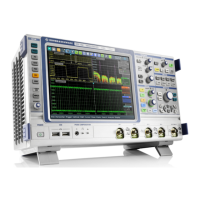
